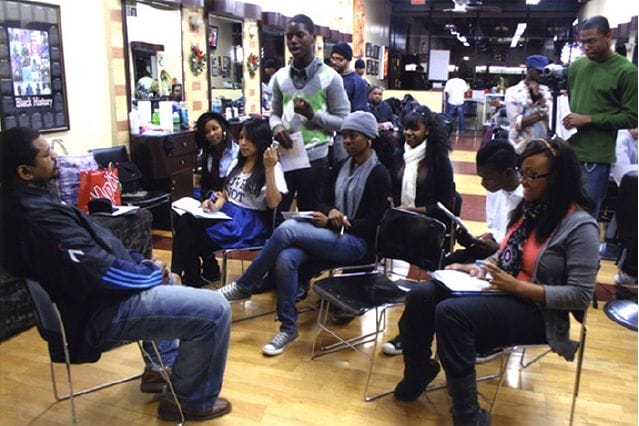
Participants in the Dr. Beverly J. Robinson Community Folk Culture Internship Program at Mind-‐Builders Creative Arts Center in the Bronx, New York, interview master barber Dennis “Denny Moe” Mitchell about his two decades of experience. Photo by Jade D. Banks
The Will to Adorn initiative has seen many iterations: fieldwork, satellite research projects and dissertations, youth presentations and projects, and, most spectacularly, the 2013 Smithsonian Folklife Festival program. Of these, however, the one that might show the most long-‐term difference is the Will to Adorn Youth Access Program, which has partnered with community organizations all over the country to engage young people in direct fieldwork in their communities.
In 2010, inspired by a long working relationship and collegial goodwill, the Smithsonian Center for Folklife and Cultural Heritage (CFCH) formalized its partnership with Mind-‐Builders Creative Arts Center in the Bronx, New York, and specifically with its Beverly J.
Robinson Community Folk Culture Program. The Folk Culture Program, directed at the time by teaching artist and community scholar/lay folklorist Jade D. Banks, hired teen and young-‐adult interns for a period of months, usually during the summer, and trained them to do fieldwork: photo and video documentation, fieldnotes, interviewing, and more. In 2010 the Folk Culture Program started doing this work with a Will to Adorn focus. Teens produced thousands of gigabytes of data, hosted fashion shows, mini-‐exhibits, and presentation nights at local community venues, and, most importantly, began to see themselves as cultural practitioners with something to say.
Inspired by the success at Mind-‐Builders, the CFCH staff wished to expand the model. We received a 2013 grant from the Smithsonian’s Youth Access Program, followed by a second grant in 2014, to partner with more organizations doing similar arts-‐and-‐culture work in communities. We were also able to build on a relationship with Debra Robinson, a teacher at an Atlanta-‐area high school who had worked on some of the early Will to Adorn fieldwork at Spelman College. These two anchor programs provided models for us when approaching prospective partners. Our target audiences remained middle-‐ and high-‐school aged students and their educators. Since directed learning also takes place in community settings and venues that offer flexibility beyond the classroom, we primarily recruited in out-‐of-‐school settings.
By spring 2013, seven additional partners had been selected. They came to us by several methods: following recommendations of existing research partners, asking folklorists in specific communities for recommendations, and serendipity. These partners represent a broad range of programming and target audiences, including Title I and alternative schools, faith-‐based groups, arts and community organizations, urban youth-‐focused initiatives, and organizations working with adjudicated youth. The work in 2014 has focused upon developing and nurturing design thinking while continuing to address competencies that have been identified as part of the core education standards, particularly literacy, analytic skills, writing, primary research skills, communication, and team work, as well as basic technical skills.
Now, what to do? We had chosen deliberately diverse organizations, each working with a slightly different target audience. After selecting these partners, CFCH invited all nine to Washington, DC, for intensive training in the midst of the 2013 Smithsonian Folklife Festival. Longtime Will to Adorn educators Jade D. Banks and Debra Robinson were joined by Bonnie Sunstein, author of Fieldworking: Reading and Writing Research, plus Lisa Rathje and Paddy Bowman of Local Learning. They each led workshop sessions covering an aspect of the project within their expertise. We worked with Jade to adapt Mind-‐Builders’ lesson plans into a draft Will to Adorn curriculum, which we shared with the new partners. Following the workshop, eight organizations were able to extend their participation through the second week of the festival; youth participants from three organizations collaborated to document various aspects of the festival relating to dress and adornment. Spontaneous discussions throughout the festival days added to the group’s understanding of the larger Will to Adorn initiative, and as they worked with each other they grew excited to begin their own projects upon returning to their home cities. For me, one of the most exciting aspects of the Youth Access Project was working with six former youth interns from New York and Atlanta, now aged 17 to 29, at the festival to help train and support the younger students.
I’m thrilled that this inaugural edition of the Journal of Folklore and Education highlights several Youth Access partners’ programs in the following pages. These organizations are doing profound work and making a difference in the lives of the young people they serve.
Sally A. Van de Water has been at the Smithsonian Center for Folklife and Cultural Heritage since early 2013, when she was hired to manage the Will to Adorn Youth Access Program. She was coordinator for the 2013 Smithsonian Folklife Festival The Will to Adorn: African American Diversity, Style, and Identity program and is project manager for CFCH’s symposium Intangible Cultural Heritage: An International Dialogue. Ms. Van de Water has facilitated national meetings of cultural heritage professionals on behalf of the American Folklore Society, National Assembly of State Arts Agencies, and National Endowment for the Arts, and has a long history of managing public programs, cultural events, and public folklorists’ convenings. She has an AB in Folklore and Folklife from Bryn Mawr College and an MA in Folk Studies from Western Kentucky University.
